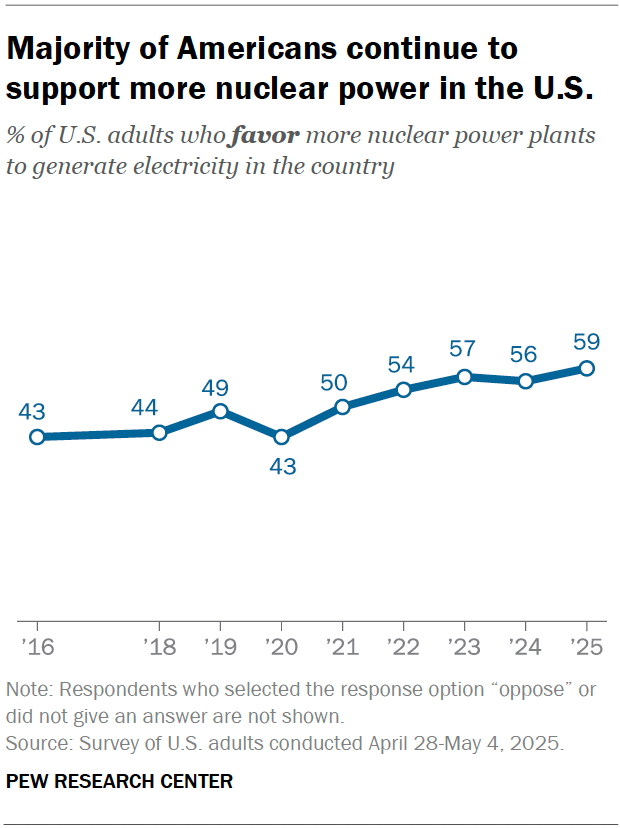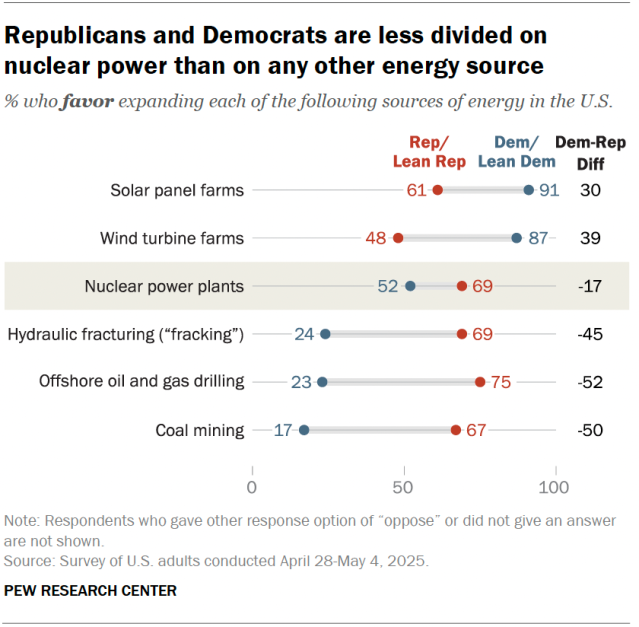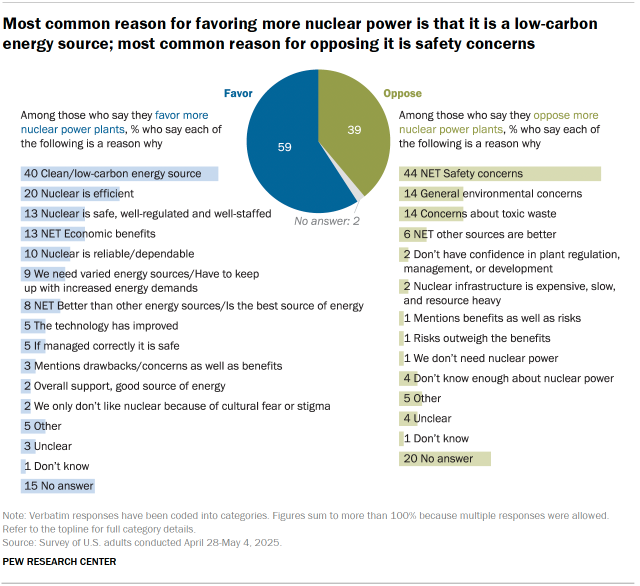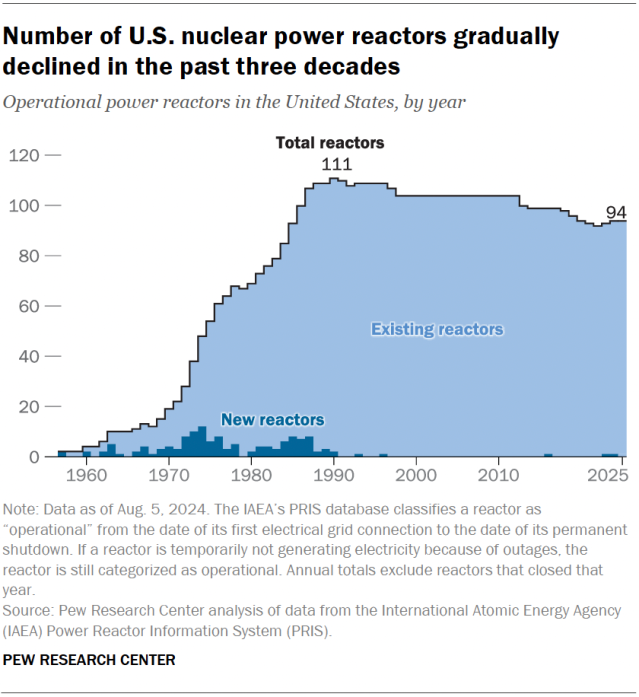
About six-in-ten U.S. adults now say they favor more nuclear power plants to generate electricity, according to a Pew Research Center survey fielded in April and May. That’s up from 43% in 2020, driven by increasing support among both Republicans and Democrats.

The Trump administration and Democrats and Republicans in Congress support expanding nuclear power. The second Trump administration has issued four executive orders aimed at dramatically increasing the United States’s nuclear capacity. And a major law President Donald Trump signed in July 2025 preserved many tax incentives for nuclear power.
Americans remain more likely to favor expanding solar (77%) and wind power (68%) than nuclear power (59%). But while support for solar and wind power has declined by double digits since 2020 – largely driven by drops in Republican support – the share who favor nuclear power has grown by 16 percentage points since then.
Views by gender
Attitudes on nuclear power production have long differed by gender.
In our April-May survey, men remain far more likely than women to favor expanding nuclear power plants to generate electricity in the U.S. (74% vs. 44%). This pattern holds among adults in both political parties.
Views on nuclear energy differ by gender globally, too, according to a Center survey conducted from fall 2019 to spring 2020. In 18 of the 20 places surveyed, men were more likely than women to favor using more nuclear power as a source of domestic energy.
Views by party

Republicans are more likely than Democrats to favor expanding nuclear power to generate electricity in the U.S. Roughly seven-in-ten Republicans and Republican-leaning independents (69%) say they favor this, compared with about half of Democrats and Democratic leaners (52%).
Republicans have supported nuclear power in greater shares than Democrats each time we’ve asked this question since 2016.
The partisan gap in support for nuclear power (17 percentage points) is smaller than those for other types of energy, including fossil fuel sources such as offshore oil and gas drilling (52-point gap) and coal mining (50 points).
Americans in both parties see nuclear power more positively now than they did earlier this decade. The share of Democrats who favor expanding it is up 15 points since 2020, and Republican support has grown by 16 points.
While younger Republicans tend to be more supportive of increasing domestic renewable energy sources than their older peers, the pattern reverses for nuclear energy. For example, Republicans under 30 are more likely than those ages 65 and older to favor more solar panel farms (69% vs. 53%). But they are 14 points less likely than the oldest Republicans to support expanding nuclear power (61% vs. 75%).
Why Americans favor or oppose expanding nuclear power in their own words
We also asked Americans to share the main reason they favor or oppose more nuclear power in their own words.
Among those who favor more nuclear power, the most common reason why is that it is a clean or low-carbon way of producing energy (40%). As two respondents wrote:
“[Nuclear power plants] are currently the only carbon-free form of power generation capable of producing large amounts of power efficiently, and without the downside of being dependent on weather conditions.”
“They are a clean source of energy that can produce a massive amount of energy for the amount of money and time invested in them.”
Some of those who favor more nuclear power also say this because it is efficient (20%) or safe (13%):
“We’ve learned to maintain safety with nuclear power. (Think of military usages such as submarines and aircraft carriers.) It’s clean and waste can be safely handled.”
Other reasons highlighted include economic benefits (13%), reliability (10%) and the need for more varied energy sources (9%) as reasons they support nuclear power.
Among those who oppose more nuclear power, safety concerns are the most common reason (44%). This includes respondents who say nuclear power is generally not safe, mention risks of catastrophe and risks to human health.
“If something were to go wrong, it could be catastrophic.”
“[Nuclear power plants] are dangerous, and I don’t trust humans to be responsible enough to take the necessary safety precautions.”
Other reasons for opposing nuclear power include general concerns about its environmental impact (14%) and specific concerns about toxic waste (14%). For instance, one respondent wrote:
“Nuclear power plants tend to set radiation off and it destroys our environment.”

A look at U.S. nuclear power reactors

The U.S. currently has 94 nuclear power reactors, including one that opened in Georgia last year. Reactors collectively generated 18.2% of all U.S. electricity that came from utility-scale facilities in 2024, according to preliminary data from the U.S. Energy Information Administration.
About half of the United States’s nuclear power reactors (48) are in the South, while nearly a quarter (22) are in the Midwest. There are 18 reactors in the Northeast and six in the West, according to data from the International Atomic Energy Agency (IAEA).
The number of U.S. reactors has fallen since peaking at 111 in 1990. Nine Mile Point-1 – located in Scriba, New York – is the oldest U.S. nuclear power reactor still in operation. It first connected to the power grid in November 1969.
Most of the 94 current reactors began operations in the 1970s (41) or 1980s (44), IAEA data shows. (The IAEA classifies reactors as “operational” from their first electrical grid connection to their date of permanent shutdown.)
Within the last decade, eight reactors shut down, and just three new reactors joined the power fleet.
One of the many reasons nuclear power projects have dwindled in recent decades may be the perceived dangers following nuclear accidents in the U.S. and abroad. For example, the 2011 Fukushima Daiichi accident led the Japanese government and other countries to rethink their nuclear energy plans. High construction costs and radioactive waste storage are also often-cited hurdles to nuclear energy development.
Still, many advocates say that nuclear power is key to reducing emissions from electricity generation. Tech companies have also expressed recent interest in reviving decommissioned nuclear power sites, including Pennsylvania’s Three Mile Island and Iowa’s Duane Arnold, to power large artificial intelligence-focused data centers. Michigan’s Palisades plant, which shuttered in 2022, could become the first recommissioned reactor this year.
Note: Here are the survey questions used for this analysis, the topline and the survey methodology. This is an update of a post originally published on March 23, 2022.


